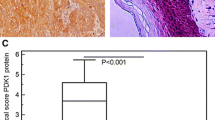Abstract
A human oncoprotein-designed cancerous inhibitor of PP2A (CIP2A) has been recently identified, which can stabilize c-Myc protein by inhibiting its degradation mediated by protein phosphatase 2A (PP2A) in tumor cells and promote the proliferation of various cancer cells. Esophageal squamous cell carcinoma (ESCC) is a highly aggressive cancer with poor prognosis worldwide. However, the underlying molecular mechanism of the development of ESCC is still poorly understood. In the present study, the CIP2A expression between normal and malignant esophageal tissues was compared by immunohistochemical analysis; moreover, the mechanisms of CIP2A-mediated tumorigenesis were investigated by evaluating its role in cell proliferation, cell cycle, apoptosis and senescence. We found that the positive staining of CIP2A was found in 36 of 40 (90%) of cancer tissues, whereas only 8 of 40 (20%) normal esophageal mucosa exhibited positive CIP2A staining. The CIP2A is significantly overexpressed in human esophageal tumors when compared with normal tissues (χ2 = 39.6, P < 0.01). On the other hand, the CIP2A expression was not associated with age, gender, tumor burden, or differentiation status. Depletion of CIP2A expression led to impaired clonogenicity and senescence, which is the primary mechanism of CIP2A in oncogenesis. Therefore, CIP2A may be a candidate in diagnosis and therapy of esophageal cancer.




Similar content being viewed by others
References
Sablina AA, et al. The tumor suppressor PP2A Aβ regulates the RalA GTPase. Cell. 2007;129:969–82.
Calin GA, et al. Low frequency of alterations of the α (PPP2R1A) and β (PPP2R1B) isoforms of the subunit A of the serine-threonine phosphatase 2A in human neoplasms. Oncogene. 2000;19:1191–5.
Junttila MR, Westermarck J. Mechanisms of MYC stabilization in human malignancies. Cell Cycle. 2008;7:592–6.
Yeh E, et al. A signaling pathway controlling c-Myc degradation that impacts oncogenic transformation of human cells. Nat Cell Biol. 2004;6:308–18.
Junttila MR, et al. CIP2A inhibits PP2A in human malignancies. Cell. 2007;130:51–62.
Li W, Ge Z, Liu C, et al. CIP2A is overexpressed in gastric cancer and its depletion leads to impaired clonogenicity, senescence, or differentiation of tumor cells. Clin Cancer Res. 2008;14:3722–8.
Albertsson M. Chemoradiotherapy of esophageal cancer. Acta Oncol. 2002;41:118–23.
Izzo JG, et al. Cyclin D1 guanine/adenine 870 polymorphism with altered protein expression is associated with genomic instability and aggressive clinical biology of esophageal adenocarcinoma. J Clin Oncol. 2007;25:698–707.
Bahnassy AA, Zekri AR, Abdallah S, El-Shehaby AM, Sherif GM. Human papillomavirus infection in Egyptian esophageal carcinoma: correlation with p53, p21, mdm2, C-erbB2 and impact on survival. Pathol Int. 2005;55:53–62.
Kanda Y, et al. Analysis of gene amplification and overexpression in human esophageal-carcinoma cell lines. Int J Cancer. 1994;58:291–7.
Dimri GP, et al. A biomarker that identifies senescent human cells in culture and in aging skin in vivo. Proc Natl Acad Sci USA. 1995;92:9363–7.
Khanna A, et al. MYC-dependent regulation and prognostic role of CIP2A in gastric cancer. J Natl Cancer Inst. 2009;101:793–805.
Xu D, et al. Switch from Myc/Max to Mad1/Max binding and decrease in histone acetylation at the telomerase reverse transcriptase promoter during differentiation of HL60 cells. Proc Natl Acad Sci USA. 2001;98:3826–31.
Coˆme C, et al. CIP2A is associated with human breast cancer aggressivity. Clin Cancer Res. 2009;15:5092–100.
Arroyo JD, Hahn WC. Involvement of PP2A in viral and cellular transformation. Oncogene. 2005;24:7746–55.
Lowe SW, Cepero E, Evan G. Intrinsic tumour suppression. Nature. 2004;432:307–15.
Braig M, et al. Oncogene induced senescence as an initial barrier in lymphoma development. Nature. 2005;436:660–5.
Chen Z, et al. Crucial role of p53-dependent cellular senescence in suppression of Pten-deficient tumorigenesis. Nature. 2005;436:725–30.
Acknowledgments
We would like to thank Dr. Jihui Jia for his skillful technical assistance and invaluable discussion.
Conflict of interest
The authors declare that they have no competing interests.
Author information
Authors and Affiliations
Corresponding author
Rights and permissions
About this article
Cite this article
Qu, W., Li, W., Wei, L. et al. CIP2A is overexpressed in esophageal squamous cell carcinoma. Med Oncol 29, 113–118 (2012). https://doi.org/10.1007/s12032-010-9768-9
Received:
Accepted:
Published:
Issue Date:
DOI: https://doi.org/10.1007/s12032-010-9768-9




